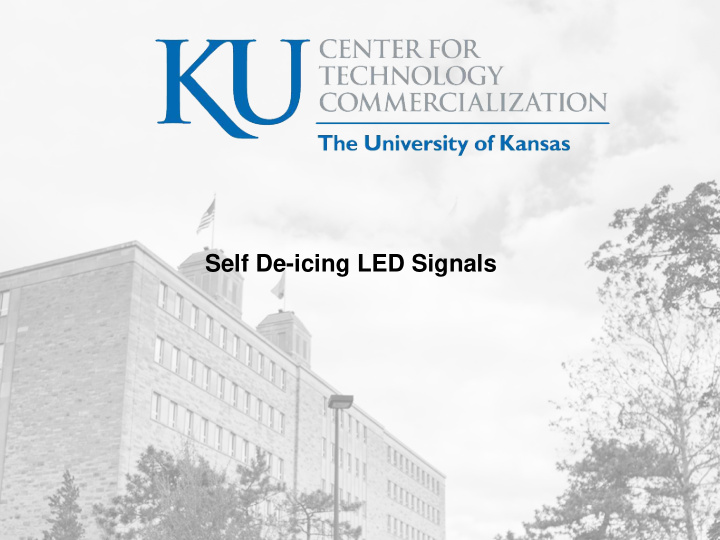



Self De-icing LED Signals
OPPORTUNITY • PROBLEM – Existing LED traffic light lenses are unheated- snow and ice accumulation on the lenses – Incandescent lamps melt ice but not energy inefficient • SOLUTION – KU technology maintains LED traffic light lenses at above- freezing temperatures by mounting the LED lights “backwards” to harvest the heat generated by the LED to heat the lens – Technology solves a notable safety hazard • PRODUCT Self de-icing, energy efficient LED Traffic lights without additional heat generator and control sensors www. ku ctc .ku.edu
MARKET • This invention targets the market for LED traffic lights in snowy climates – 39 states, 70% of the US population and all of Canada are located in snowy regions – There are around 300,000 U.S. intersections using traffic signals, in addition to thousands of railroad LED signals. – Most traffic signals in the US are LEDs – Replacing existing cool LED lights will save $ 28.1 dollars /signal light annually (payback in 4.51 years) – Potential savings would be in millions annually (New York, with its 12,460 signals, could save $8.4 million every year) www. ku ctc .ku.edu
TECHNOLOGY • Existing LED traffic lights are cool in the front on the lens • The LEDs generate heat (70-80% of the input energy) that is wasted • KU invention harnesses this heat using a passive heat exchanger • This heat is used to heat the lens to maintain an above-freezing lens temperature • Light is re-directed from the LED to the front lens via fiber cables and diffusers Patent Pending www. ku ctc .ku.edu
FEATURES AND BENEFITS FEATURES • Use and placement of a heat sink to harness the heat • Reversed LED + light collector + fiber optic cables BENEFITS • Illumination and heating • No external heat generators or sensors • Retrofitting is possible/ no extra installations • No accumulation of snow and ice on the lens • Increases safety and visibility www. ku ctc .ku.edu
VALUE PROPOSITION • A self de-icing LED signal light that can be retrofitted into conventional LED signal lights for melting and deicing without any additional heat generators or sensors • Useful for signaling, illumination, and heating
NEXT STEPS • Build prototypes of the self de-icing LED signals and test them in the field • Looking for both funding and development partners www. ku ctc .ku.edu
Recommend
More recommend